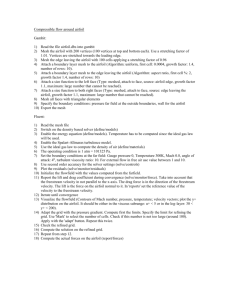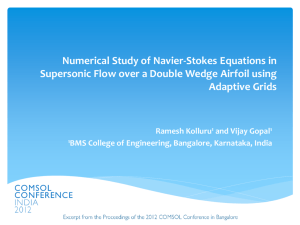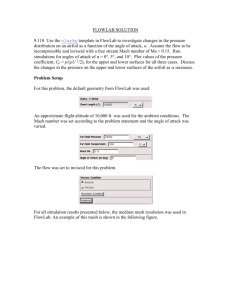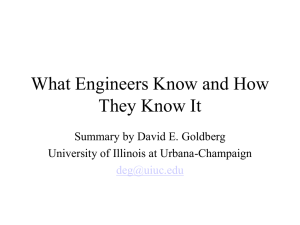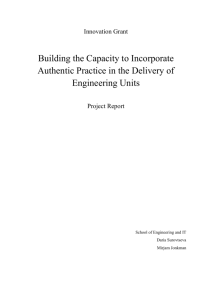Lab Instruction - Aerospace Engineering
advertisement
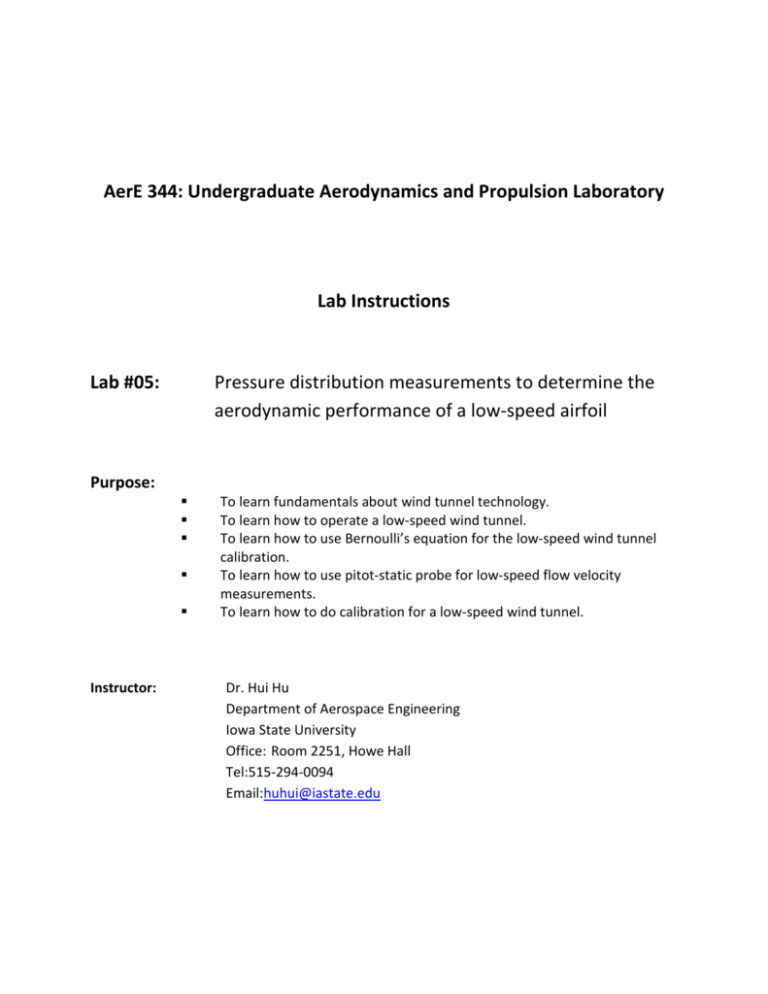
AerE 344: Undergraduate Aerodynamics and Propulsion Laboratory Lab Instructions Lab #05: Pressure distribution measurements to determine the aerodynamic performance of a low-speed airfoil Purpose: Instructor: To learn fundamentals about wind tunnel technology. To learn how to operate a low-speed wind tunnel. To learn how to use Bernoulli’s equation for the low-speed wind tunnel calibration. To learn how to use pitot-static probe for low-speed flow velocity measurements. To learn how to do calibration for a low-speed wind tunnel. Dr. Hui Hu Department of Aerospace Engineering Iowa State University Office: Room 2251, Howe Hall Tel:515-294-0094 Email:huhui@iastate.edu AerE344 Lab 05: Determination of the Aerodynamic Performance of a Low‐Speed Airfoil based on Pressure Distribution Measurements In this lab exercise you will use the pressure sensor you calibrated last week along with two Scanivalve pressure transducer DSA3217 units to acquire pressure from the pressure taps around a GA(W)-1 airfoil in order to determine the aerodynamic performance of the airfoil. What you will have available to you for this lab: • A Pitot probe already mounted to the floor of the wind tunnel for acquiring dynamic pressure throughout your tests. • A Setra manometer to be used with the Pitot tube to measure the incoming flow velocity. • A thermometer and barometer for observing ambient lab conditions (for calculating atmospheric density). • A computer with a data acquisition system capable of measuring the voltage from your manometer. • The pressure sensor you calibrated last week • A GA(W)-1 airfoil that can be mounted at any angle of attack up to 16.0 degrees. • Two 16‐channel Scanivalve DSA electronic pressure scanners. Steps: • Choose a primary operator and have the TA record your choice. • Choose a wind tunnel velocity at which to conduct your tests (incoming flow velocity = 10~15m/s is recommended). • Connect tubing to supply wind tunnel static pressure (from the Pitot tube static port) to the reference port of your pressure sensor. • Make sure that the Setra manometer pressures are connected properly. • Conduct your airfoil pressure measurement experiments. o Use the Scanivalve to measure pressures about the NACA 0012 airfoil in the Bill James Tunnel. o Measure pressure distributions for the following angles of attack: o AOA = −4°, 0°, 4°, 6°, 8°, 10°, 12°, 14°, 16° and/or any others you wish. You can set the angle of attack by mounting the protractor on the end plate of the airfoil model in the wind tunnel. o Important: DO NOT TOUCH THE AIRFOIL WHEN CHANGING THE ANGLE OF ATTACK. ONLY HANDLE THE BARS ON EACH END. o Repeat your measurements by resetting the airfoil at the above angles of attack as many time as you have time for. This will give you an opportunity to reduce your precision uncertainty. Required Plots • Plots pressure coefficient ( CP ) distributions about the airfoil for some typical angles of attack considered. • Plots of CL, CD and CM over the whole range of angle of attack you considered. -1- Calculating airfoil lift coefficient (CL ), drag coefficient (CD ), and moment (coefficient) (Cm,LE , ) by numerically integrating the surface pressure distribution around the airfoil: Figure 1. Pressure tap numbering convention Y/C First, recall that the surface pressure taps are numbered in the counterclockwise direction as shown in Fig. 1. Although it may seem somewhat unintuitive at first, this numbering convention allows us to formulate relevant equations in a very generic way. 0.15 0.10 0.05 0 -0.05 -0.10 0 0.1 0.2 0.3 0.4 0.5 0.6 0.7 0.8 0.9 1.0 X/C Figure 2. GA(W)-1 airfoil and pressure tap locations. -2- Table 1: The coordinate of the pressure taps on the GA(W)-1 airfoil. • • • TAP 1 is at the airfoil leading edge (LE) and TAP21 is at the airfoil trailing edge (TE) TAP 2-20 are along the lower surface, TAP 22-43 are along the upper surface The chord length of the airfoil is 101mm, i.e., C = 101mm. With the convention, the airfoil surface is broken into N panels. The i‐th panel is bounded by the i‐th and i+1‐th taps at (xi, yi) and (xi+1, yi+1) respectively. The exception is that the Nth panel is defined by(xN, yN) and (xi, yi) but in your spreadsheet or program, you can treat this by adding a fictitious N+1‐th tap which simply takes on the value from the first tap. Consider the i‐th panel shown in Fig.2, where pi+1/2 represents the pressure (assumed to be) acting on the i‐th panel. Let -3- If we assume the pressure variation on the i‐th panel to be constant at pi+1/2 as defined by Eq.1, this is equivalent to trapezoidal true integration. Furthermore, define Figure 3. Discrete representation of the airfoil surface element Note that Δx and Δy can be negative because x and y are not monotonic in the index i. Using Eqs.1 and 2, the normal and axial components of the pressure force acting on the i ‐th panel can be written as where the prime indicates a two‐dimensional quantity (force per unit span). Similarly, the moment contribution from the i‐th panel to the total moment about the leading edge can be written as -4- Note that aerodynamic moment is defined to be positive in the pitch ‐up direction. Now that we have derived the expressions for the differential force and moment from each panel, we can integrate them over the airfoil surface. Finally, the lift and drag per unit span can be obtained as follows. -5- Writeup Guidelines The report for this project should be a formal report. See course website for the details on exactly what constitutes a formal report. Required Plots: • Plots of CL, CD and CM vs. angle of attack for the GA(W)-1 airfoil. • Plot of CP at angle of attack AOA = −4°, 0°, 4°, 6°, 8°, 10°, 12°, 14°, 16° for the GA(W)-1 airfoil. • Plot of dynamic pressure vs. the pressure drop between the inlet and out let of the wind tunnel contraction for the small calibration wind tunnel (including a curve fit). Your report must provide details on: • The flow speed you used for the airfoil pressure distribution measurements. • Discussion of the plots of the pressure coefficient ( CP ) distributions of the airfoil. • Discussion of CL, CD and CM calculated from your CP distributions—and how you calculated them. • Estimates of the location of the stagnation point for each angle of attack you consider. • Estimate of the stall angle (if possible) from your measurements. • Tunnel velocity, Reynolds number of tests (with respect to the airfoil chord length of 12 inches). • Discussion about the results of the small wind tunnel calibration tests. -6- -7-


